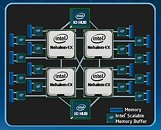- Joined
- Oct 9, 2007
- Messages
- 47,308 (7.52/day)
- Location
- Hyderabad, India
| System Name | RBMK-1000 |
|---|---|
| Processor | AMD Ryzen 7 5700G |
| Motherboard | ASUS ROG Strix B450-E Gaming |
| Cooling | DeepCool Gammax L240 V2 |
| Memory | 2x 8GB G.Skill Sniper X |
| Video Card(s) | Palit GeForce RTX 2080 SUPER GameRock |
| Storage | Western Digital Black NVMe 512GB |
| Display(s) | BenQ 1440p 60 Hz 27-inch |
| Case | Corsair Carbide 100R |
| Audio Device(s) | ASUS SupremeFX S1220A |
| Power Supply | Cooler Master MWE Gold 650W |
| Mouse | ASUS ROG Strix Impact |
| Keyboard | Gamdias Hermes E2 |
| Software | Windows 11 Pro |
Intel is set to introduce a series of eight-core Xeon server processors later this month, that are capable of running in four-socket servers. With HyperThreading technology enabled, each core can handle two threads, taking the logical CPU count on such servers up to 64. Each Nehalem-EX chip has 8 CPU cores with dedicated L2 caches of 256 KB, a shared L3 cache of 24 MB, and Turbo Boost technology that helps conserve power while also stepping up performance when needed. The die also features a memory controller with four DDR3 memory channels. Being based on the Nehalem architecture, the chips are built on the 45 nm HKMG process.
In related news, Intel will also introduce Westmere-EP processors later this month. These chips will be based on the 32 nm Westmere architecture, and are likely to have 6 cores, up to 12 logical CPUs per chip, 12 MB of L3 cache and three DDR3 memory channels. These chips will be suited for two-socket servers and workstations.

View at TechPowerUp Main Site
In related news, Intel will also introduce Westmere-EP processors later this month. These chips will be based on the 32 nm Westmere architecture, and are likely to have 6 cores, up to 12 logical CPUs per chip, 12 MB of L3 cache and three DDR3 memory channels. These chips will be suited for two-socket servers and workstations.

View at TechPowerUp Main Site
Last edited:







 btarunr
btarunr 




